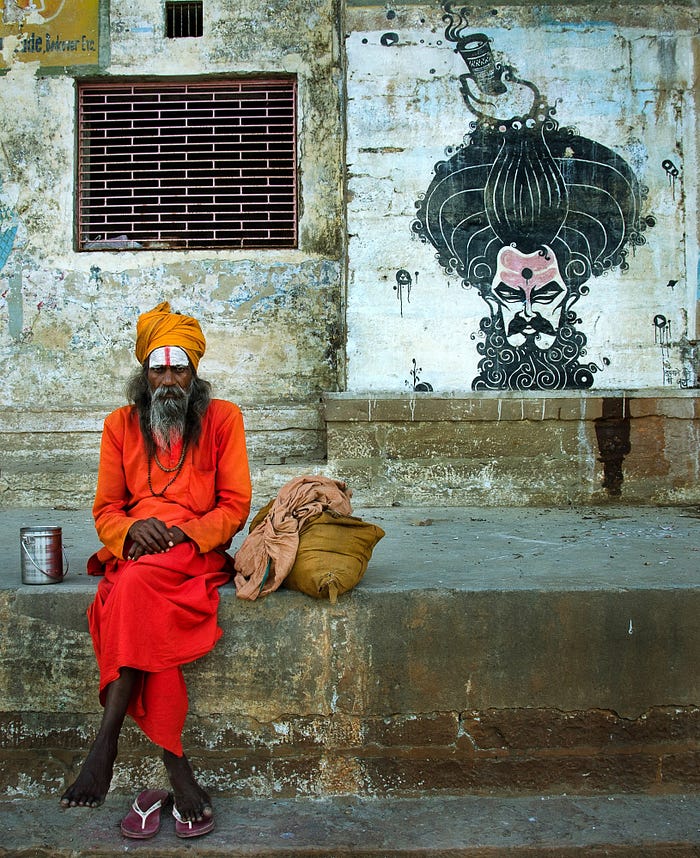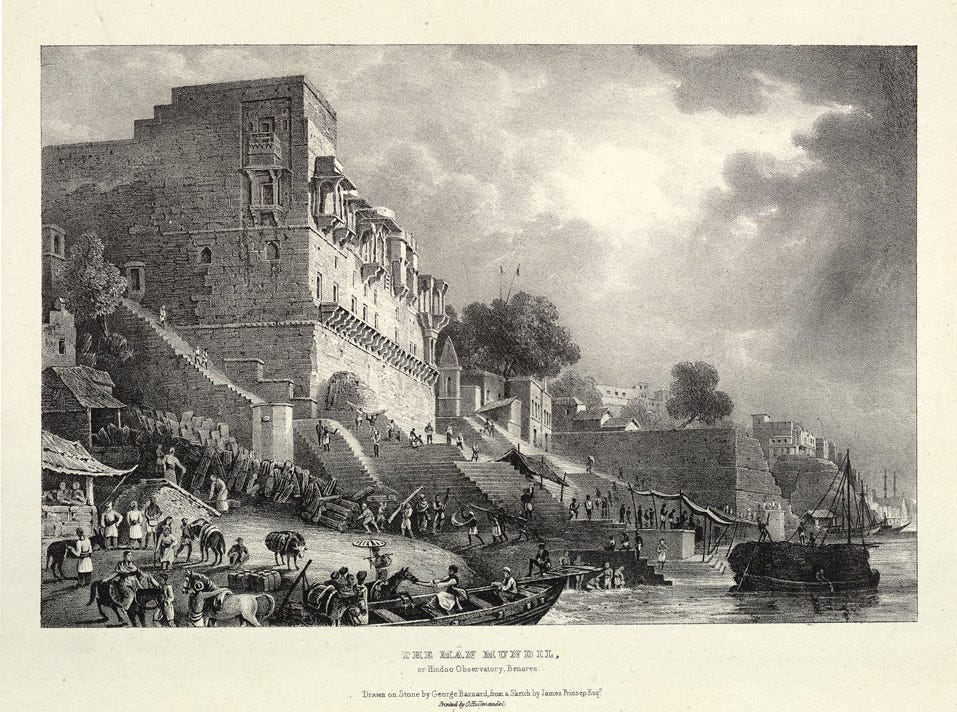Varanasi is a scream, a crash course in faith and a hallucinatory trip, and in each of these, an intense sensory overload.
As with thousands of pilgrims-tourists that have appeared here every day for centuries, I was hoping the city herself will respond. But she did not; she remained aloof, busy with business on the ever-busy ghats, neither welcoming nor rejecting the stranger that has arrived at its doorsteps. For she has seen far too many of them over millennia, of all shapes, sizes, humilities, and hubris, and perhaps a sense of fatigue has set in.
She does not offer you a welcome drink or a faux welcome smile, nor does she turn you away from its threshold. There ain’t a neat glossy brochure, with a list of sites to visit, restaurants to eat at, preferred spots to take a selfie from, post on social media, and be done with it. You are allowed to roll in with your fancy Delsey suitcases, to the guesthouse in a slender street that barely allows two people to walk abreast, skirting the local bull that is perched across its length. It just never occurs to the bull to give you the way, or to Varanasi to provide for broader streets where taxis could deposit the travelers at the hotel.
But please, don’t get her wrong, for she is not miserly in sharing her experiences, letting you partake in it as much as you want. She is only expecting you to open up to new ideas that may or may not retrofit with sensibilities what you came herewith.
In terms of antiquity Peking, Mecca, Athens, Jerusalem, and Rome come to mind. But there is an important difference — At Varanasi life reaches back to 2500 years in a continuous tradition. It’s not excavated, merely re-constructed, after each conquest and desecration. Only if we could imagine Agora, Acropolis in Greece, or Forum in Rome still alive and living, with its classic intellectual and cultural heft, we might appreciate the remarkable tenacity of life in Varanasi. Today’s Peking, Athens, or Jerusalem move by a very different ethos from the one that moved them in ancient times.
“Banaras is older than history, older than tradition, older even than legend, and looks twice as old as all of them put together!” And for once, Mark Twain’s hyperbole was on the mark, because this city contains the richest tapestry of enduring history, myth, and custom, per square inch. ‘Banaras’ was the anglicized corruption of Varanasi — the land between Varna and Asi (rivers). Other names are Kashi — City of Light, AviMukta (Never Forsaken), AnandVana (Forest of Bliss)…

The place is a challenge to photograph. It’s very crowded, too many things take effect, and too fast. Every crevice and by-lane holds the promise of life bursting through unexpectedly — A palm-sized blood-red hanuman statue at the base of a tree trunk, a deadlocked baba seeking nirvana in the haze of charas smoke, verses of Kabir scrawled in chalk, half washed away by the rains. Instinct smells possibilities at every few steps, but there is no time to arrange the shot. I try to visualize it, anticipate it, and then pray for it to appear. My heart pounds at 120 a minute, and I am afraid to put on a zoom lens, get intimate with my frames. So I keep my wide lens on and go trigger happy, believing, at some point, the law of averages will grant me a few keepers.
Following are the notes and pictures from a brief trip.
We stayed at a ramshackle AirBnB at Assi–hosted by Martin–a Spanish Musician, living here for the past 9 years. He landed in India during his backpacking Gap year and has lived here ever since. When I showed surprise, he replied, “Well, you know, the time has a manner of passing quickly in India.” He invited us over to his evening gigs at a local hotel, anytime during our stay.
The house was ready to fall, scarcely held up by Jasmine vines that covered its frontage, and it offered an impressive view of the Ganges from the roof. Our ‘room’ was on the first floor, a bare 12’X10’, with an en suite, Indian style toilet. No TV. Thin cotton mattresses were spread out on the ground, and he had overlooked to put a spare sheet to cover. An old fan whirred languidly on the ceiling. There was a shared small kitchenette, refrigerator, and bathroom.
A Belgian lady, who only photographed in medium format film, took up the adjacent room–and her film stock occupied most of the communal refrigerator. The remaining two rooms were with Martin, chock-a-block with musical instruments, used on weekends for jamming.
The ground floor was rented to other artsy folks, whom we didn’t get to meet; though snatches of flute, beauteous and pure, drifted up to our balcony all three mornings we were there.
Martin, present-day Van Gogh, had found his Arles here at Assi.
Walk along the Ghats
“We will try Ravioli and a Margarita, with extra Jalapeño please.” An Italian lunch order felt quaintly out of place while we sat on the sun-dappled terrace of Vaatika Pizzeria at the Assi Ghat. Navalji, a family friend and our local contact, was now doing us a ready introduction to the place.
“What you see, from here to there,” he waved at the miles-long successive row of steps receding into the river, half-obscured with the smog that had risen over the river, “are some 80 odd ghats, over some 3–4 miles. You guys are lucky that Ganga Maiya is running low today… we can hike the full length of the old city from one set of staircases to the next without ever using a single city street.”
Thus started our quick introduction to a city that involves tons of tales, myths, customs, thousands of temples, hundreds of deities and minor gods, and their ONE supreme commander — Shiva. This is the realm of faith, where unshaped stones in the slot of a tree trunk are worshipped, a derelict temple claims to be 10000 years old, and a muddy pool of sluggish water is a sea of nectar. I knew that left-brain logic had to be silenced here, but my head still buzzed at times with incredulity.
Shiva-Parvati & Kashi Connection
Banaras is the city of Shiva — without doubt, the most fascinating God in the pantheon of many. He is the original rockstar. He confounds the traditional ideals of the celestial. He is a creature of duality. He is the god of creation and destruction. He contradicts conventions and lives on the fringe of culture. He is not troubled with purity, nor does he spurn the polluted. He hasn’t cared for reverence of family, lineage, or status. He left the Himalayas to reside in the heart of culture here at Varanasi, yet he made his home here in a cremation ground. He anoints his body with the ashes of the dead, rides a bull, and wears snakes on his neck as ornaments. Most people are disturbed when first told what Shiva Linga represents.
The love story of Shiva and Parvati is remarkable too. In brief, beautiful Parvati, the daughter of Himalaya, and younger sister of Ganges falls in love with Yogi Shiva, subjects herself to endless austerities to win him over, until the ascetic Shiva agrees to marry her. On the wedding day, Shiva shows up in deadlocked matted hair, coated from head to toe in ash, wearing the fresh skin of an elephant that was dripping with blood. He came inebriated and his baraat was similarly blissed out. The bride’s mother fainted, and father nearly had a heart attack. Parvati has a quiet word with Shiva, so he comes back in a more presentable form, and they solemnize the marriage.
After marriage, Parvati’s father insists on a proper place of living for his daughter, and thus Varanasi is chosen. It was then the most splendid place on earth, at the peak of culture and affluence, and ruled virtuously by King Divodasa. Gods then indulge in a little trickery to get the city vacated and its competent king removed, thus making way for the new couple’s abode. Somewhere in this process, Ganges, the sister of Parvati, also falls down and starts coursing through Varanasi.
The extreme traditions of Shiva worship still live in Aghoris (fearless) here, and their macabre tantric rituals. The mainstream pilgrims’ chant of “Har Har Mahadev” resonates at temples.
One of the names of this city is Rudravasa–The City of Shiva.

“There is hardly any major religious shrine in Banaras that has survived from before the 17th century,” Navalji was referring to repeated Muslim invasions and destruction of temples that took place over 600 years, ending with the reign of Aurangzeb. “What we see today are mostly southern ghats, rebuilt from 18th century onwards, by Marathas — Scindia, Holkar & Bhonsle, Raja Maan Singh of Amer and kings of Nepal.”
This came as a revelation, since the great skyline of Varanasi hardly seems to have changed for the last few centuries. But then most pictorial records of the city are only from the 18th century onwards, mainly by James Prinsep.


We stroll down the river from Assi to Tulsi Ghat, named after the poet-saint of the 16th century. His house and a temple remain at the top of ghat steps. Next is the palace of Maharaja Chet Singh, taking up the riverfront of Shivala Ghat. The majestic structure has fallen in decay, but it once belonged to Raja Chet Singh, who defied the tax demands of the British, even when the governor-general of India Warren Hastings, came personally to Varanasi to confront him. Chet Singh, locked up in this very palace, slipped away on a makeshift rope of turbans and rallied a local rebellion, strong enough to make Hastings flee for his life. That was the year 1781.

Next is Hanuman Ghat, where Vallabha lived in the late 15th century — scholar, philosopher, and proponent of Krishna bhakti. Adjacent is Harishchandra Ghat, one of the two cremation Ghats of Varanasi still in use — the other being Manikarnika (more on that later). We have merely walked a kilometer, but one can feel the weight of history that floats in the air.
The ghat is dedicated to the legendary King, the truthful Harishchandra (HC), who worked on this cremation grounds, under license from Dom Raja. The Story goes that a Brahmin Vishwamitra once asked King HC for a ritual fee (Dakshina)., and he, in his kindness gave him all that he owned; yet the Brahmin pressed for more. Rather than break his promise, HC came here destitute, sold his wife and son into slavery, and went into service of Doms, to work the cremation grounds to pay the fee. He did not see his loved ones again until the day his wife, worn with hardship, came to the cremation ground carrying their son’s body. He had died of snakebite and she did not even have a sheet to cover the corpse. HC, obliged by his pledge, still insisted on the cremation fee, per the terms of his bondage to Doms… In the end, the Gods rewarded his sense of duty and restored his throne and his son.
The story is meant as a moral parable for the strength of his character but sounds ridiculously off-beat to modern sensibilities.
“Like other tirthsthal in India, the priest and pandas here offer unique plans to fit the pocket and fitness levels of the average pilgrim. A popular option is ‘Panch Tirth’, or ‘Panch Koshi yatra’, where one prays at five specific temples, and is assured all the fruits of heaven, and the slate is cleaned of all the past sins,” Navalji was saying, “If still hard-pressed for time, then a mere dip in the holy river (and a small dakshina) will also do.” He chuckled at us questioning — I mused the idea of a dip, Neeta was more ambitiously planning a private puja at Kashi Vishvanath.
Next is a quiet section of the riverfront, where dhobis are slapping wet clothes on the stone slabs. The locality is called Bengali-Tola, settled by Bengalis, many of whom have moved here for Kashivasa — living out one’s days in Kashi until death. We break for a cup of tea at a makeshift hawker’s and strike a conversation with a Babaji — he was a pehalwan (wrestler) in his younger days.

Navalji explains — “Death is a celebration in Banaras, for centuries, a sure ticket to moksha, the much-needed break from the cycle of reincarnation. Lodges and salvation homes exist in the city, run by charities or communities — catering to kashivasis, men and women who come to live–and die–in Kashi. They have even made a movie about it — Mukti Bhawan.” I shudder at this head-on approach to mortality but made a note of checking out the movie later.
A couple of unimpressive ghats later — Mansarovar, Narad Ghat, etc… we arrive at the Dasashvamegha Ghat, the most famous and the most populated Ghat along the Ganges. Per the legend, this was the place where Lord Brahma performed the sacrifice of ten thoroughbred horses, hence the name Dasaswamedh.

Rows of pundits and purohits, sit on low wooden stools under the bamboo umbrellas, eager to extend the priestly and the practical needs of pilgrims. They tend to the clothing and effects of bathers; and offer myriad religious services of divine nature, ending the ritual with a vermillion tilak on the forehead. In exchange, the pilgrims offer the traditional gift of a cow (Godan), but nowadays a couple of hundred rupees are a reasonable proxy.
We are hungry and need sustenance. It’s fun to get lost in the maze of lanes and by-lanes, in the old parts, and the city keeps springing surprises. There are several fond memories of stray interactions.
The food here is fun and not of an expensive kind, borrowing from streets of UP and Bihar. Allo-kachori and piping-hot jalebis at ‘Chachi ki Kachori’, an open kitchen set up under an old tree for a few morning hours, followed by Pahalwaan ki Lassi, near BHU. The spicy litti–chokha served with green chili and chutney (ah, the perfect combination)! Kashi Chaat at Godowlia — Choora Matar, Tamatar Chaat, Dahi Chutney Golgappe… the list goes on. Long-Lata, Makhan-Malai, Rabri Jalebi, for the sweet tooth. Chaiwallahs and their kadak chai on the ghats…. This all is making my mouth water as I write this.
Slowly down the Ganges
The alarm bleeps and I wake up disoriented, flat on the floor, in a dimly lit small room with moss green walls, and a lizard next to the night bulb. Oh, we are in Varanasi; I realize a moment later. It’s 4.30 AM and I and Neeta get ready to head to Assi Ghat for ‘Subah-e-Banaras’ and the boat ride. The ghat is a mere half kilometer away, and the air has a slight chill. We walk past a row of kacha huts, with rickshaws chained to the nearest pole or to each other. At this hour the street is quiet, almost serene, a far cry from the daytime throngs we witnessed the previous day. Municipal poles throw a glob of an amorphous cone of sulphuric light on the potholed street, every hundred yards or so. Cows lay curled against the doorways to these shanty huts; few water buffalos lazily munch at their cud, but largely ignore us. The air smells of freshness, dew, and traces of dung bonfire. We make our way in that checkered darkness, avoiding the cow dung and such land mines. A motorbike vrooms past.
At the Assi Ghat, small groups huddle around the handful of open stalls, sipping Chai while others are busy organizing the logistics of Aarti. Across the road, two lonely figures stood, faces illuminated by the flame of a match, taking their first nicotine hit of the day. In one corner, a havan is going on, with a few pilgrims seated in a circle.

Suddenly, in a single file a line of immaculately dressed boys, in their orange robes, arrives with huge brass lamps, shaped like heads of a serpent. They perform morning arti, with much fanfare and coordinated movements, in a veil of swirling smoke and flickers of fire. Touristy, but impressive spectacle.
Along with the modest crowd we sit in awe, watching as the sky behind the boys turns cobalt blue, with a sliver of tangerine. It’s only 6 AM and sunrise is still some 15 minutes away, as the last embers of the morning ceremony fade.
Our local fixer Ajit leads us down the steps, to Babu, a lean boatman with sinewy arms. Neeta and I sat astern, and he took his position in the bow and pulled his oars.
Next to the Ghat’s hubbub, the Ganges is deep and quiet; the swish of oars is a soft whisper on the vast river. More boats push out, some with camera-toting tourists, others with pilgrims, humming a religious hymn. We slowly row downstream, past Tulsi, Chet-Singh, and Hanuman Ghats. The endless succession of ghats, with tall ramparts and protruding temple spires, is shrouded behind a veil of fog. At a closer distance, faint ghostly figures had crept down in dozens, wading in the holy river.
Babu recounts the story of the goddess Ganga, when brought down from heaven to this earth, was so powerful that only Lord Shiva’s hair could hold the currents. Now its holy waters course through the land, bringing the devout to its banks to wash away sins. As if to drive home the point, he scoops and drinks a palm-full of water from the river, expecting us to follow suit. We let it pass, failing yet another test of devotion.
We pass a ghat where men/women slapped their laundry against flat rocks. Two women held opposite ends of a wet sheet, pulled it taut, set it on rocks to dry. Rows of blessed clothing, of different shapes, colors, and sizes, flutter on clotheslines. This must be the holiest launderette in the world.
Sun has broken through the horizon, covering the entire riverbank in a golden patina. The endless steps of ghats are bright and startling as an Indian miniature painting — the pilgrims are now in scores, then in hundreds, and then in thousands along the coast. In the backdrop, centuries-old temples and weathered four-story residences, deep red and yellow, with high balconies rise. The sweep of Ganges is huge, the current is powerful, its color sea green, and it doglegs to right about a mile ahead. I feel goosebumps on my arms…

Overawed by the unfolding scene, we watch in silence. The vibe is ethereal, one’s body responds to it, but the mind takes longer to process. We are mid-stream, distant enough from the hustle of humanity at the Ghats; the swish-swash of oars is playing on a steady beat, and the twitter of myriad birds is the only other sound. Believer or atheist, it doesn’t matter — this is the real deal.
Babu stops rowing, the boat bobs on water, we hover in near silence. There are countless other boats around, but in those few moments, I felt I was alone. Babu hands us little bowls with marigolds, with a lighted diya in each, and nods at us to put them in the water. With a silent prayer on our lips, we watch the speck of saffron float away. Boatman starts to row again–we are approaching Dasaswamedh Ghat.
The spell is broken — the riverfront is jammed with hundreds of penitent men stripping down to underwear, women in saris, stepping into the water’s edge, looking sunwards, hands pressed together. One man lifted a bowl of river water and sluices it over his head; another plunges under the surface, yet another dips a cup and drinks heartily.

(We returned to this ghat next evening to watch the Ganga Aarti. This time we were sharing our boat with a young French girl, on a multiyear project at BHU, who spoke chaste Hindi. The ghat had converted into a large performance platform. Hundreds of boats floated along the steps, slowly crashing into one another, with sounds of conch shells, bells, chants, and smoke from incense sticks and massive brass lamps.)
The boat rows on. We cross towering rust-red palace and observatory that once belonging to the Jaipur royal family. On the raised embankment a deadlocked swami is having his first hit from Chillam, and a couple of youths are weight lifting, wearing tiny G string langots. The names of ghats are carelessly painted onto the medieval walls, along with random slogans and graffiti.

We pass under the palace of the Dom Raja, the lord of the funeral pyres, hereditary chief of the Doms — the undertaker caste, responsible for all the cremations in Varanasi. There are tales of Dom’s wealth and their family tree goes back before the time of Raja Harishchnadra who worked as their serf, a million years ago!
We are closing into the ghat of Manikarnika. On the shore ahead, we see a row of funeral pyres, some burning, others ashen, sending up flames and smoke. An eerie awareness takes hold, and I switch off my camera, and just look, feeling like a trespasser, into someone else’s sacred space… and their private pain.

Hindu scriptures say that dying and getting cremated along the banks of the holy Ganges breaks the cycle of rebirth and gives Moksha (salvation). It is a theological belief that accepts life and death as a harmonized whole. Manikarnika Ghat, its water grey from industrial and human waste, is believed to wash away the sins of even the worst transgressors. As our boats slowly glide past, priests and the families of the departed can be seen murmuring prayers for the soul, amid a thick cloud of smoke; the smell of sandalwood and burning flesh hangs in the air. Somehow, the reality of seeing so many bodies dispatched in the heart of a bustling city of millions is too abstract to be horrific.
“Every fire on this ghat is lit from a dhuni (sacred fireplace) that has been burning continuously here since Satya Yuga. It is not for anyone to bring their own matchbox!” Babu informs quietly. Yet, Manikarnika comes as a slap-in-the-face encounter with mortality.
We tell our boatman to row on, please.
A prickle of warmth hits my neck as the sun has risen, or maybe it’s the intensity of what we just watched. Our jumpers come off as we glide along with a half-submerged temple at Sindhia Ghat. Looking around, one sees a lot of misshapen construction that has taken place on top of things that existed before. Centuries have layered over each other, like a palimpsest of an old parchment that has been written upon frequently and erased, again and again, leaving the old layers partially visible.

Now we are at Panchganga ghat (junction of 5 rivers), the last of major ghats along the northern banks, with an imposing skyline and the dome of Alam Giri mosque abutting at the extreme end. This is the section that most suffered from repeated Muslim conquests, and desecration, starting from 12th century Delhi Sultanate (Qutub-ud-din — Firoze Shah Tuglaq — Sikandar Lodi) and ending with Aurangzeb in the 17th.
This is where Bindu Mahadeva once stood in its sublime glory. This is where Kabir, a low caste weaver, is said to have extracted the sacred blessings from Ramananda by lying on the steps before daybreak and waiting for the guru to stumble over him when he showed up for a bath early in the morning. (When Ramananda came down the steep stairs and fell over Kabir, he shouted “Ram! Ram!” in surprise; and Kabir considered himself blessed!). Nearly a century later, but still, during the epoch of grand Bindu Mahadev, Tulsidas wrote in its honor. This is where outcaste Brahmin poet Jaggannath sat with his Muslim lover and composed Ganga Lahiri.

In place of Bindu Mahadev, now stands Alam Giri mosque, popularly known as Gyan Vaapi Mosque, which itself has gone through modifications — its tall columns were cut down, as it could not bear the weight of its own hubris.
The other disaster was a nasal recorded message, droning in a loop on a loudspeaker, singing paeans of Modi and his Swatcha Bharat campaign.
Beyond this, the succession of Ghats becomes much less ornate. Many of the Ghats are still clay banked kachla Ghat, in a section of the city that is largely Muslim, and devoid of the patronage or funds needed for finer construction.
Along the Ganges, it is heat, crowds, pollution, beggars, temple touts, and an occasional carcass floating down the river. It all is too much to process together. You instead escape to the streets, where its motorbikes, dilapidated cars, lumbering buses, three-wheelers, battered rickshaws, squeaky bicycles, pushcarts — all crowding in, vying for space, turning one lane to two, two to four, coursing around cows and water buffalo. The crush of human numbers, the palimpsest of medieval architecture layered upon by concrete ugliness, the hissing charge of frayed electric wires, monkeys, dogs, the incessant din….
My nerves jangle. I need to take deep breaths; I need to find a quiet moment, just watch the river drift by, and wait for my heartbeats to slow down.
But once my heartbeat tapers, I start to feel the presence of three hundred thirty million gods, goddesses, yakshas, ganas, bhairavas, reportedly in residence here. It’s a city that sustains the living and emancipates the dead. It is an enduring embodiment of 2500 years of faith, from Vedic to Tantrik, wrapped in myth, superstition, and tradition. Kashi gently shows itself and its richness, weaves enchantments with its countless stories, shares its secrets and reveals its wounds incurred over centuries.
Banarasis have a Joie de vivre–of mauj, masti & fakkadpan. Life’s pleasures are honest–a morning swim in the river, a boat ride to the opposite shore, an hour at Akhara, a post-dinner stroll for a Maghai Paan…
And the resident pandas can be accomplished conman with false bluster that Neeta saw firsthand, at Kashi Vishwanath Abhishek Puja. Even I got duped by a young paan-waala off some 50 rupees! Harmless tricks of the trade played on naïve pilgrims!

Sun is about to come up the horizon, and the skies are a rich cobalt blue. Nearby, a group of aged ladies huddles on the ghat. They have perhaps traveled a few days to arrive here, and are staying in a dharamshala close by. They are humming a song, words that I don’t recognize. A potpourri of cheap religious paraphernalia — betel leaves, a picture postcard of Shiv-Parvati, bundles of sacred threads, some flowers, vermillion, incense sticks… is spread out between them. An old matriarch amongst them is now helped into the river, held by two other women, for the current is strong. She raises her hands in a jal-stuti, just as a sliver of orange emerges across the east. Two diyas, in leaf cups, with marigold and a burning flame, bob on the shimmering water. I press shutter, and make the frame…
…And feel grateful, for the city has shown a world far bigger, and interesting, beyond the limited, sterile sensibilities I arrived with.
Epilogue — Kashi Vishwanath (KV) Corridor
In 2019, BJP leadership announced KV corridor — an ambitious Rs 600 crores project to open pedestrian corridors for the hundreds of thousands of pilgrims who visit each year. The area was earlier made up of serpentine narrow lanes, lined with older structures that had fused with new ones, over the generation — shops on the lower floors, and homes above. Dozens of hidden shrines, some dating back centuries, were discovered as residents’ dwellings toppled — some 300 of them, and displaced 600 families in the process.
This was one of the most congested and colorful parts of the old city. Any time of the day, a chaotic medley of holy chants, mixed with the hustle of street shopkeepers, harried locals, and gawking tourists, reclining cows and lazy dogs shared the confines of those narrow lanes. Walls covered with street art and graffiti…
Like a Jackson Pollock’s splatter of paints — the grime and the sublime existed cheek a jowl.
Instead, the new dispensation is offering gardens, lavatories, shops, a performance space, a heritage library, offices for the temple workers, and a ‘mandir chowk’. Construction will be of Makrana & Baleshwar Marble, pilgrims will use clean walkways on the riverfront, with piped music, and water coolers every 100 yards. Here, the government of the day has chosen order, over organic chaos. To me, it looks like Pollock is binned in favor of high school art student aesthetic. But maybe there is more to it…
In 1669, Aurangzeb had razed the original Kashi Vishwanath temple at the center of this renewal project and erected the mosque atop it. But 2019 desecration is ordained by a government that wears Hindutva on its sleeves! Expectedly, the liberals fear this to be the master plan to create another flash point, around the Gyan Vaapi mosque, now that the ambers of Babri Majsid have died.
And I wonder, why worry? This is not the first time this magnificent city has been seen violated… and certainly not the last. Next year, let the government organize “Navras Rock Festival” on those platforms, keeping up with the musical traditions of the city. And why stop there, maybe parcel out the pieces of centuries-old heritage to the private sector on a PPP model. And hope, by then, the trusting public has turned into willing lambs-ready to be slaughtered by the highest bidder.









